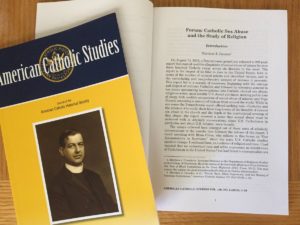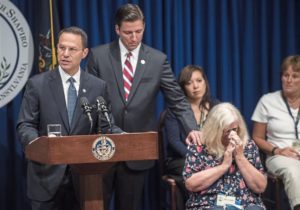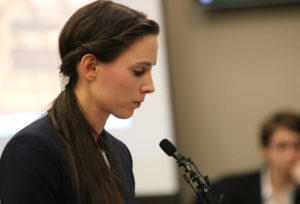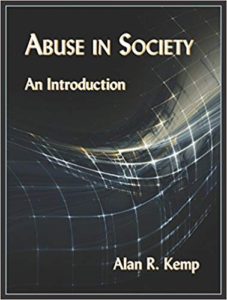American Catholic Studies: Forum on Catholic Sex Abuse and the Study of Religion
What do scholars of Catholicism have to say about the abuse crisis?
On August 14, 2018, a Pennsylvania grand jury released a nine hundred-page report that named credible allegations of the sexual abuse of minors by more than three hundred Catholic clergy across six dioceses. The report is the largest of its kind to date in the United States, both in terms of the number of accused priests and identified victims, and in the excruciating and comprehensive account of the violence it presents. This report led to a cascade of responses: the outrage and disgust of ordinary Catholics, attorney generals in ten states announcing investigations into Catholic clerical sex abuse, U.S. Jesuit provinces making public lists of clergy with credible accusations of the sexual abuse of minors, and Pope Francis convening summits of bishops from around the world. While the Pennsylvania report offered nothing new—Catholics and the scholars who study them have long known of the breadth of clerical sex abuse and the depth of the institutional coverup of that abuse—the report renewed a sense that sexual abuse must be reckoned with in academic conversations about U.S. Catholicism and religion in America.
 What follows is an excerpt from one such scholarly conversation, which began as an “emergency session” at the American Academy of Religion in November 2018 and published as a special forum in the Summer 2019 issue of American Catholic Studies. In it, six scholars reflect on the Catholic clerical sex abuse crisis. The forum opens with Brian Clites (Case Western Reserve) offering ten theses on why scholars must center survivors in their accounts of Catholic sex abuse. Susan Ridgely (University of Wisconsin) describes how children abuse victims have been marginalized in scholarship and how we can remedy that. Jeremy Cruz (St. John’s University) focuses on educators’ obligation to challenge institutional structures of violence. Jack Downey (University of Rochester) reveals how the racism and colonialism endemic to the U.S. Catholic Church has prevented scholars from seeing, let alone understanding, sexual abuse in indigenous communities. Kathryn Lofton (Yale University) asks what the Catholic sex abuse crisis can teach us about abuse in other contexts, particularly within the hierarchical spaces of the academy.
What follows is an excerpt from one such scholarly conversation, which began as an “emergency session” at the American Academy of Religion in November 2018 and published as a special forum in the Summer 2019 issue of American Catholic Studies. In it, six scholars reflect on the Catholic clerical sex abuse crisis. The forum opens with Brian Clites (Case Western Reserve) offering ten theses on why scholars must center survivors in their accounts of Catholic sex abuse. Susan Ridgely (University of Wisconsin) describes how children abuse victims have been marginalized in scholarship and how we can remedy that. Jeremy Cruz (St. John’s University) focuses on educators’ obligation to challenge institutional structures of violence. Jack Downey (University of Rochester) reveals how the racism and colonialism endemic to the U.S. Catholic Church has prevented scholars from seeing, let alone understanding, sexual abuse in indigenous communities. Kathryn Lofton (Yale University) asks what the Catholic sex abuse crisis can teach us about abuse in other contexts, particularly within the hierarchical spaces of the academy.
In the following excerpt from the forum, Julie Byrne (Hofstra University) argues that we should think about Catholic abuse as part and parcel of the sexual abuse pervasive in our society writ large. In contrast to other contributors to the forum, she warns against overemphasizing the Roman Catholic (or religious) dimensions of abuse.
The forum as a whole grapples with difficult questions about how we understand sexual abuse in Catholic contexts and the imperatives that arise from that understanding. Not everyone agreed on the answers. And so I encourage you to engage the full forum, free and accessible to the public for the month of March 2020, courtesy of American Catholic Studies and Project Muse. — Matthew Cressler, editor of the “Forum on Catholic Sex Abuse and the Study of Religion”
***
“The Distortions of Exceptionalism, Again”
by Julie Byrne
My highest hope for discussion of the Roman Catholic sex abuse crisis is that it would take context and comparison into account with regard to the larger phenomenon of sex abuse.

Pennsylvania Grand Jury Announcement
Before I explain, I beg in advance that readers not mistake my brief words for excusing or minimizing. I grew up Catholic in Lebanon County, Pennsylvania. When the latest Pennsylvania grand jury report came out, my four siblings and I realized that over the course of thirty years we had personally interacted in parish and school contexts with four priests on the list, which is at least 20 percent of the total number of priests we knew. My sister was a student at Lebanon Catholic High School when one of those priests was her principal, who one day called her and spoke a lot of sex talk into the phone. My brother was a young man considering a vocation when another of those priests invited him into his office, closed the door, and lowered the shades. For some reason it did not go further, as we read it had with other boys—our classmates—in similar scenarios with that same priest. We have vivid memories of cover-up standards as mass announcements, such as, “Please pray for Father so-and-so, he had a nervous breakdown.”[1]
It is precisely because of the personal experience of me and so many others that I am very invested in knowledge-based activism for change. To me that starts with letting go of exceptionalizing the Roman church situation.
This is the context: child sex abuse is not particular to Roman Catholicism, because Roman Catholicism is not exceptional.
In the study of Catholicism, exceptionalism has been a huge problem. Historically it posited that the Roman church was exceptionally better than most, or that it was exceptionally worse than most. But in the case of the sex abuse crisis, I see a more subtle exceptionalism, including by scholars usually careful about assuming religion is inherently good, which basically suggests “the Roman church should be better than most.” Should be better?, than thousands of rapes of children and cover up of cases? Sure, it should be better. But it’s not, because it’s not exceptional and never has been. Roman Catholicism is just part of culture, as are all religious institutions.
And culture in patriarchy features the sexual abuse of children at atrocious rates. From what experts can tell, it happens at generally the same rate proportionate to how many children are accessible in that institution, including the institution of the family. One out of every ten children experience sex abuse of some kind before they are eighteen years old, with the highest rates for girls and trans/nonbinary kids. Statistics on the prevalence of perpetrators (both men and women) in the general population are very hard to come by, but I would point to expert estimates that ten to twenty percent of males across the board have sexually abused a minor at some point in their lives.[2]
Also cover-up is utterly endemic. No institution in which child sex abuse is committed is not guilty of denying it for the sake of its reputation, often for years or decades. This includes families, prep schools, and universities as well as churches. Though child sex abuse is illegal in the United States, we are all complicit in a patriarchal culture that ignores, excuses, or covers it up almost all the time. My best friend Michelle Morgan is a true exception. I met her at Lebanon Catholic in 1983. Now the Assistant U.S. Attorney for the Eastern District of Pennsylvania, Michelle is leading the investigation for possible federal charges stemming from the latest grand jury report. But her everyday cases involve the day-in, day-out sex trafficking of American black and brown girls that is literally endless, that media outlets do not cover, about which we are not writing pieces to contribute to a scholarly journal. We all let child sex abuse go on, simply by refusing to comprehend how normal it is.[3]

Rachael Denhollander victim statement at Nassar trial
To keep activism knowledge-based, I call for not only context but also comparativism. No institution is exceptional, but each site has its own time, place, and historical particularities. At least thirty percent of child sex abuse is “child-on-child”—that of a younger child by an older child. This is obviously much different than, say, Dr. Larry Nassar of Michigan State University and USA Gymnastics, who was recently convicted of abusing hundreds of girls to whom he had access as sports team physician. This is in turn much different than a priest abusing an altar boy, where specifically “Catholic” sex abuse happens, for example, when abusers deploy the symbols and vocabulary of Catholicism to justify abuse.[4]
Yet comparative work can track parallels, too. Another temptation to exceptionalize the Roman situation is to imagine that when priests do use the toolbox of Catholicism for abuse, it is automatically especially damaging because it affects children cosmically, killing their very souls.
I would be hesitant to universalize the experience of survivors in that way, or to say “soul death” happens only with the Catholic toolbox of abuse. Dr. Larry Nassar, for example, deployed the symbols and vocabulary of sports and medicine to justify abuse in a context where he knew his victim-patients and covering-up bosses worshipped the same gods of athletic excellence and Olympic immortality. Survivors of Nassar’s abuse described it as “soul-crushing” and “soul-shattering devastation,” said Rachael Denhollander. Nicole Reeb said her “soul has been scarred.” “All I wanted to do as a kid was go to the Olympics,” Mattie Larson testified. “I was at the height of my career and the Olympics were just one year away. Larry turned the sport I loved into my living hell.” In other words, as we already know, religion doesn’t only happen in religious institutions per se. Other institutions are capable of dealing joys as cosmic and blows as crushing.[5]
Comparativism also involves recognizing different situations within the same context. A “lived religion” approach would suggest that potentially sexually abusive interactions within Catholic contexts do not always end in perpetrator-victim relationships. Many were victimized, but some Catholic schoolchildren solicited by abusive priests actually rebuffed them or told their parents who rebuffed them. Some children and adults heard rumors and spread them, warning others to stay away from creepy priests, who became semipublic laughingstocks as well as private predators. While some victims were traumatized forever, indeed suffering “soul death” and finding Catholicism permanently toxic, others experienced abuse as a glancing event in their lives that they had the resources to handle; God was still somehow always separable or they unproblematically remained Roman Catholic. Some Catholic survivors of child sex abuse were abused not by priests, but by their Catholic fathers, mothers, uncles, cousins, or neighbors. This is “Catholic” sex abuse, too. My current research involves suburban Catholic white-ethnic upper-middle-class men. While I am attuned that some of them could have been survivors of clerical sex abuse, I’m also attuned that (chances are) some of them were abusers, mostly of young adult women at parties, in intimate relationships, and in #MeToo scenarios at work. This is “Catholic” sex abuse, too.
So, to sum up: priests don’t sexually abuse children more, Catholic kids don’t suffer it more, bishops don’t cover it up more, and religious tools of abuse don’t automatically make it especially searing. Onto the trash heap of unfounded assumptions let’s heave explanations of Catholic sex abuse based on exceptionalism. Instead, let’s keep researching and advocating based on unflinching acknowledgment of the pervasion of child sex abuse and on finely honed studies of comparative situations.
 There is some hope, because while astonishingly prevalent, child sex abuse seems not to be a timeless constant. Studies show the number of child sex abuse cases in the United States peaked in 1992 and declined annually by between two to eleven percent through the turn of the millennium. Why? “Professional opinion is divided about why this drop occurred and how much of the drop is real as opposed to reflection of factors such as changes in definitions, reporting and investigation by states,” writes Alan Kemp in Abuse in Society: An Introduction. But at least part of the decline seems to indicate a real drop. During the same time period, incarceration rates for sex offenders multiplied, while overall crime rates and measures of family problems such as domestic violence and teen pregnancy dropped, all of which suggest “a general improvement in the well-being of children,” Kemp writes. In addition, millions of public schools implemented sex ed curricula that included “safe bodies” lessons teaching children to recognize others’ attempts at inappropriate physical contact.[6]
There is some hope, because while astonishingly prevalent, child sex abuse seems not to be a timeless constant. Studies show the number of child sex abuse cases in the United States peaked in 1992 and declined annually by between two to eleven percent through the turn of the millennium. Why? “Professional opinion is divided about why this drop occurred and how much of the drop is real as opposed to reflection of factors such as changes in definitions, reporting and investigation by states,” writes Alan Kemp in Abuse in Society: An Introduction. But at least part of the decline seems to indicate a real drop. During the same time period, incarceration rates for sex offenders multiplied, while overall crime rates and measures of family problems such as domestic violence and teen pregnancy dropped, all of which suggest “a general improvement in the well-being of children,” Kemp writes. In addition, millions of public schools implemented sex ed curricula that included “safe bodies” lessons teaching children to recognize others’ attempts at inappropriate physical contact.[6]
Study of Roman Catholic sex abuse, then, should investigate the specifics of Catholic contexts and structures, but mostly with an eye toward illuminating and cooperating with public education, policy, and law that continue to improve the well-being of children overall. One could imagine this running the gamut from revamping the sex ed curricula of Catholic schools to advocating for (mostly Catholic) migrant children held in camps along the U.S. border. Only then can concern about Catholic sex abuse coalesce with the disclosure of sex abuse across religious and nonreligious institutions, sync with the #MeToo movement, and complement related pro-women-and-children justice reform initiatives. Only then will discussion of Catholic sex abuse help yield data-based modes of prevention, reveal the vulnerabilities of specific populations, generate tailored treatments for trauma, and encourage broad legal prioritization. Only then will the “Catholic sex abuse crisis” have been properly addressed as a crisis not just of the Roman church, but of society in general.[7]
***
You can read the entire American Catholic Studies “Forum: Catholic Sex Abuse and the Study of Religion” for free through March 31, 2020, courtesy of American Catholic Studies and Project Muse.
***
Matthew J. Cressler is assistant professor of religious studies at the College of Charleston and the author of Authentically Black and Truly Catholic: The Rise of Black Catholicism in the Great Migration (NYU Press, 2017).
Julie Byrne holds the Monsignor Thomas J. Hartman Chair in Catholic Studies and serves as Professor of Religion at Hofstra University. Her second book, The Other Catholics: Remaking America’s Largest Religion, was published by Columbia University Press in 2016.
***
[1]. Kristina Papa, “Two Accused Priests Served as School Principals,” WNEP-16, August 2, 2018, https://wnep.com/2018/08/02/two-accused-priests-served-as-school-principals/; Brandie Kessler, “‘Suddenly I Don’t Feel Like I am Going to Hell’: Priest Abuse Victim Reacts to Diocese Report,” York Daily Record, August 2, 2018.
[2]. Darkness to Light, “Prevalence of Child Sex Abuse,” https://www.d2l.org/the-issue/prevalence/. Pat Wingert, “Priests Commit No More Abuse than Other Males,” Newsweek, April 7, 2010, https://www.newsweek.com/priests-commit-no-more-abuse-other-males-70625.
[3]. William McSwain, “The Feds are Focused on Ending Modern-Day Slavery in the U.S.,” Philadelphia Inquirer, January 2, 2019.
[4]. Emily M. Douglas and David Finkelhor, “Child Sexual Abuse Fact Sheet,” http://www.unh.edu/ccrc/factsheet/pdf/CSA-FS20.pdf; Defend Innocence, “Five Facts About Child On Child Sexual Abuse,” https://defendinnocence.org/5-facts-child-child-sexual-abuse/; Eric Levenson, “Larry Nassar Sentenced to Up to 175 Years in Prison for Decades of Sexual Abuse,” CNN.com, January 18, 2018, https://www.cnn.com/2018/01/24/us/larry-nassar-sentencing/index.html; Robert Orsi, “What is Catholic About the Clergy Sex Abuse Crisis?” in The Anthropology of Catholicism: A Reader, eds. Kristin Norget, Valentina Napolitano, and Maya Mayblin (Berkeley: University of California Press, 2017), 282–292.
[5]. James Terence Fisher used the phrase “soul death” to describe the effect of clergy sex abuse in discussion of my Facebook post on this topic on August 18, 2018, https://www.facebook.com/julie.byrne.3388/posts/2097864687092104; Rachael Denhollander with Morgan Lee, “My Larry Nassar Testimony Went Viral. But There’s More to the Gospel Than Forgiveness,” Christianity Today, January 18, 2018, https://www.christianitytoday.com/ct/2018/january-web-only/rachael-denhollander-
larry-nassar-forgiveness-gospel.html; Laura Mazade, “ ‘By the Way, Enjoy Hell’: Read the Words of the Many Women Who Confronted Larry Nassar,” Lansing State Journal, January 16, 2018, https://www.lansingstatejournal.com/story/news/2018/01/16/larry-nassar-sentencing-victim-statements/1037631001/.
[6]. Alan R. Kemp, Abuse in Society: An Introduction (Long Grove, IL: Waveland Press, 2017), 156–157.
[7]. Kaya Oakes, “In Search of Spiritual Healing,” America (October 2, 2017), 28–33.